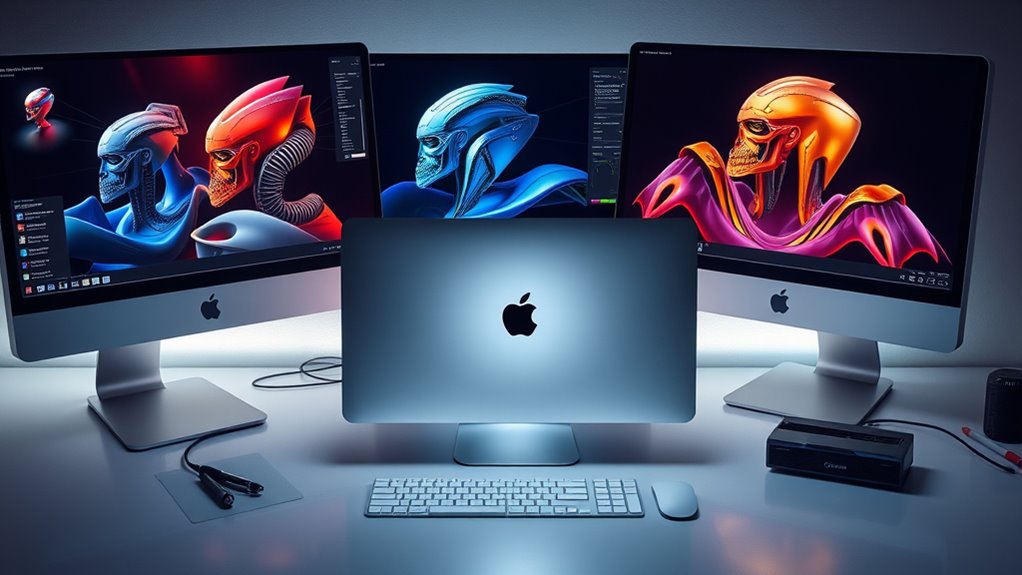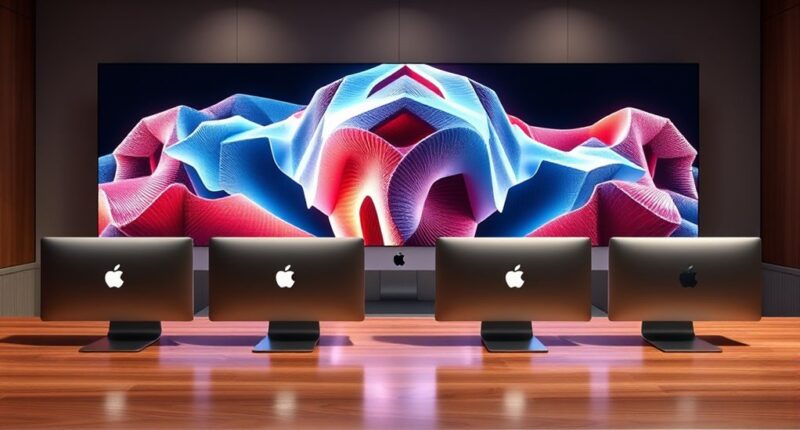If you’re looking for the best Mac Studio models for 2025, I recommend focusing on those equipped with high-core CPUs and powerful GPUs, like the latest M4 Pro configurations. These deliver top-tier processing, excellent graphics performance, and ample memory for complex 3D rendering. Such setups minimize render times and handle large models effortlessly. If you want more detailed insights on the top options optimized for power, performance, and precision, keep exploring further.
Key Takeaways
- Prioritize Mac Studio models with high-core CPU configurations (M4 Pro or higher) for faster rendering workflows.
- Select models equipped with powerful GPUs and multiple core counts to handle complex 3D textures and detailed models.
- Opt for models with at least 32GB RAM and fast SSD storage to prevent bottlenecks during large project rendering.
- Ensure models offer extensive connectivity, including Thunderbolt 4 and multiple display support, for efficient external workflows.
- Focus on premium configurations that balance cost with top-tier processing power, maximizing productivity and rendering precision.
Apple 2024 Mac mini Desktop Computer with M4 Chip
If you’re looking for a compact yet powerful desktop for 3D rendering, the Apple 2024 Mac mini with M4 chip is an excellent choice. Its sleek aluminum design measures just 5 x 5 inches, making it highly space-efficient and portable. Despite its small size, it offers impressive performance with a 10-core CPU, 10-core GPU, and a 16-core Neural Engine, delivering faster speeds and better AI tasks. It supports up to three displays and 24GB of unified memory, perfect for demanding workflows. Connectivity is extensive, with Thunderbolt 4, HDMI, Ethernet, and more—ideal for flexible setups. Quiet and energy-efficient, it balances power and size seamlessly.
Best For: users seeking a compact, high-performance desktop for demanding workflows like 3D rendering, creative tasks, and multitasking in a space-efficient setup.
Pros:
- Compact, sleek aluminum design measuring just 5 x 5 inches, highly space-efficient and portable
- Powerful performance with a 10-core CPU, 10-core GPU, and 16-core Neural Engine, supporting demanding tasks
- Extensive connectivity options including Thunderbolt 4, HDMI, Ethernet, and support for multiple high-resolution displays
Cons:
- Lack of USB-A ports may require adapters for older peripherals
- Base model’s 16GB RAM could limit performance in very demanding workflows
- Power button relocated to the bottom, which might be less intuitive to some users
Apple Mac mini Desktop Computer with M4 Chip and 16GB Memory
The Apple Mac mini Desktop Computer with M4 Chip and 16GB Memory stands out as an excellent choice for creative professionals and enthusiasts who need a compact yet powerful machine for 3D rendering. Its small size—just 5 inches square and 1.5 pounds—belies its performance, thanks to the advanced M4 chip with a 10-core CPU, 10-core GPU, and 16-core Neural Engine. The device handles demanding tasks like rendering and editing smoothly, supported by fast storage options and extensive connectivity, including Thunderbolt 4 and multiple display support. Its silent operation and energy efficiency make it ideal for tight spaces, providing impressive power in a tiny form factor.
Best For: creative professionals and enthusiasts seeking a compact, powerful desktop for demanding tasks like 3D rendering, video editing, and multitasking.
Pros:
- Small, space-saving design with lightweight and sleek aluminum finish
- Powerful M4 chip with high CPU, GPU, and Neural Engine performance boosts
- Extensive connectivity options supporting multiple high-resolution displays and fast data transfer
Cons:
- Lack of USB-A ports requires adapters for legacy peripherals
- Base model’s 16GB memory may limit performance in heavy workflows
- Power button located at the bottom may be less intuitive to find
Apple Mac mini Desktop Computer with M4 Pro chip
For creative professionals seeking a compact yet powerful workstation, the Apple Mac mini with M4 Pro chip offers an impressive combination of size and performance. Its small footprint (5 x 5 inches) and lightweight (around 1.5 pounds) make it easy to place anywhere, while the sleek aluminum design adds a premium touch. Powered by the M4 Pro with a 12-core CPU, 16-core GPU, and neural engine, it handles demanding tasks like 3D rendering, video editing, and AI with ease. Although it has limited ports—requiring adapters—it operates quietly and efficiently. Overall, it’s a versatile, space-saving powerhouse perfect for users who need high performance in a compact form.
Best For: creative professionals and power users seeking a compact, high-performance desktop for demanding tasks like video editing, 3D rendering, and AI applications.
Pros:
- Small, lightweight design fits easily in any workspace
- Powerful M4 Pro chip with high CPU and GPU performance
- Supports multiple high-resolution displays and energy-efficient operation
Cons:
- Limited ports, requiring adapters for USB-A devices
- Power button placement may be less intuitive for some users
- Base model’s memory and storage configurations might restrict intensive workflows
Apple 2024 Mac mini Desktop Computer with M4 Chip
Thanks to its compact design and powerful M4 chip, the 2024 Apple Mac mini is an ideal choice for creative professionals who need a high-performance desktop that fits seamlessly into tight spaces. Measuring just 5×5 inches and weighing 1.5 pounds, it offers extensive connectivity, including Thunderbolt 4, HDMI, Ethernet, and USB-C ports. Powered by the M4 chip, it delivers a 20% CPU boost, improved GPU performance, and enhanced AI capabilities, making it perfect for demanding tasks like 3D rendering. Its quiet operation, energy efficiency, and ability to handle multiple displays make it a versatile, space-saving powerhouse for any creative workflow.
Best For: creative professionals and users seeking a compact, high-performance desktop with extensive connectivity and support for multiple high-resolution displays.
Pros:
- Compact, lightweight design that fits easily into tight spaces
- Powerful M4 chip with significant CPU, GPU, and AI performance improvements
- Quiet operation and energy efficiency for a pleasant user experience
Cons:
- Lack of USB-A ports requires adapters for some peripherals
- Power button placement at the bottom may be less intuitive
- Base model’s 16GB memory may limit demanding workflows without upgrades
Factors to Consider When Choosing Mac Studio for 3D Rendering

When choosing a Mac Studio for 3D rendering, I focus on several key factors to get the best performance. Understanding your processing power needs, GPU performance, memory capacity, and connectivity options helps guarantee you pick the right model. Budget also plays a role in balancing features and cost, so I consider these points carefully before making a decision.
Processing Power Needs
Choosing the right Mac Studio for 3D rendering hinges on its processing power, as this directly impacts how quickly and efficiently your projects come to life. High core counts in multi-core CPUs are essential, as they markedly reduce rendering times and improve workflow efficiency. While GPU performance is also crucial, focusing on CPU capabilities ensures faster processing of complex scenes. Additionally, ample RAM allows for smoother handling of detailed models and high-resolution textures, preventing bottlenecks during rendering. Fast storage options like SSDs cut down load and save times, enabling seamless access to large project files. Supporting multiple high-resolution displays is another key factor, as it facilitates real-time previews and detailed editing. Overall, a robust processing setup is fundamental for achieving peak 3D rendering performance.
GPU Performance Levels
GPU performance levels are essential for 3D rendering because they directly influence how quickly and accurately complex scenes are processed. A GPU with higher core counts and advanced architectures can profoundly reduce rendering times and improve visual fidelity. Hardware-accelerated ray tracing support enables more realistic lighting, shadows, and reflections, elevating project quality. The GPU’s capabilities also determine how well your setup can handle multiple high-resolution displays and large texture files without lag. Performance is often measured through benchmarks that compare rendering speeds and frame rates across different hardware configurations. When choosing a Mac Studio, prioritizing a GPU with robust performance levels ensures you’ll meet demanding rendering tasks efficiently and achieve professional-grade results.
Memory Capacity and Speed
Having ample memory capacity is vital for 3D rendering because it allows me to work with larger, more detailed models and textures without slowing down. Higher RAM capacity, like 32GB or 64GB, lets me handle complex projects smoothly and prevents bottlenecks in the workflow. Faster RAM speeds improve data transfer rates, meaning I spend less time waiting for renders to process and more time refining my work. Increased bandwidth supports seamless multitasking when running multiple rendering applications or working with hefty files. Adequate and quick memory ensures my Mac Studio maintains high performance even during intensive tasks, delivering consistent, high-quality output. Choosing the right memory setup is indispensable for maximizing efficiency, productivity, and the quality of my 3D projects.
Connectivity and Expansion
When selecting a Mac Studio for 3D rendering, I pay close attention to its connectivity and expansion options to guarantee a smooth workflow. I look for models with enough Thunderbolt 4 or USB-C ports to connect multiple high-resolution monitors and external GPUs, which boost display and processing power. Supporting multiple high-bandwidth external storage devices, like Thunderbolt drives, helps me handle large rendering files efficiently. Fast Ethernet or Wi-Fi 6E connectivity is essential for quick file transfers and remote collaboration during intensive tasks. I also check for compatibility with expansion enclosures or docks that add extra USB-A or legacy ports for peripherals. Additionally, internal options such as PCIe slots or advanced GPU support enable system upgrades, ensuring the Mac Studio meets my evolving 3D rendering needs.
Budget and Cost
Choosing the right Mac Studio for 3D rendering involves carefully balancing your budget with the performance you need. Prices vary widely depending on hardware specs like CPU, GPU, and storage. If you’re budget-conscious, you might choose a base model with less RAM and storage, but that could limit rendering performance. On the other hand, investing in higher-end configurations with advanced GPUs and more memory can speed up rendering times and boost efficiency, though it increases initial costs. Don’t forget additional expenses like peripherals, external storage, and software licenses that are essential for a complete setup. Ultimately, it’s about finding the sweet spot—spending enough to meet your workload demands without overspending on features you won’t use.
Frequently Asked Questions
How Do Mac Studio Models Compare in Handling Complex 3D Rendering Tasks?
Mac Studio models excel at handling complex 3D rendering tasks thanks to their powerful M2 Ultra and M2 Max chips. I’ve found they process large, detailed projects smoothly, with quick rendering times and excellent graphics performance. Their high RAM options and advanced GPUs make multitasking effortless. If you need reliable, high-performance machines for demanding 3D work, Mac Studios are a top choice, offering impressive speed and precision.
What Are the Upgrade Options for Mac Studio’s Graphics Performance?
Sure, upgrading the Mac Studio’s graphics? It’s like trying to fit a square peg in a round hole—Apple’s design keeps it tight. You can choose the M2 Ultra with integrated graphics or opt for external eGPU solutions if you really want to boost performance. But honestly, for serious 3D rendering, I’d recommend investing in a system with dedicated GPUs or considering a PC build for maximum power.
How Does Thermal Management Impact Mac Studio Performance During Prolonged Rendering?
Thermal management is vital during prolonged rendering because it keeps the Mac Studio running at peak performance without overheating. When temperatures stay ideal, the system avoids thermal throttling, which can slow down processing speeds. I make certain to keep my workspace cool and use proper ventilation. This way, I guarantee my Mac Studio maintains consistent power and performance, even during intensive, extended rendering sessions.
Are There Specific Software Optimizations for Mac Studio in 3D Rendering Applications?
While some 3D rendering software offers Mac optimizations, I find that many programs still maximize performance by leveraging Apple’s Metal API. I recommend ensuring your software is updated to the latest version, as developers frequently release patches optimizing rendering workflows. Additionally, enabling hardware acceleration and adjusting preferences for better GPU utilization can make a noticeable difference, especially during intensive rendering tasks on your Mac Studio.
What Is the Typical Lifespan of a Mac Studio for High-End 3D Workflows?
A Mac Studio typically lasts around 4 to 6 years for high-end 3D workflows, depending on how demanding your projects are. I’ve found that with regular updates and proper maintenance, it remains powerful enough for professional rendering tasks. Once it starts lagging considerably or can’t keep up with new software demands, it’s probably time to think about an upgrade to stay efficient and competitive.
Conclusion
Choosing the right Mac Studio for 3D rendering isn’t just about specs—it’s about finding a balance that quietly supports your creative journey. While the perfect model may seem just out of reach at times, remember that even the most subtle improvements can open new doors. Trust in your instincts, and with patience, the right machine will reveal itself, helping you craft masterpieces that speak volumes beyond words.











